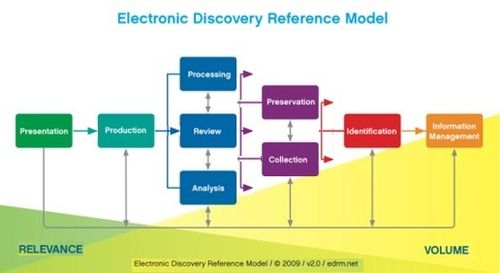eDiscovery Daily Blog
For Successful Discovery, Think Backwards – eDiscovery Best Practices

The Electronic Discovery Reference Model (EDRM) has become the standard model for the workflow of the process for handling electronically stored information (ESI) in discovery. But, to succeed in discovery, regardless whether you’re the producing party or the receiving party, it might be helpful to think about the EDRM model backwards.
Why think backwards?
You can’t have a successful outcome without envisioning the successful outcome that you want to achieve. The end of the discovery process includes the production and presentation stages, so it’s important to determine what you want to get out of those stages. Let’s look at them.
Presentation
As a receiving party, it’s important to think about what types of evidence you need to support your case when presenting at depositions and at trial – this is the type of information that needs to be included in your production requests at the beginning of the case.
Production
The format of the ESI produced is important to both sides in the case. For the receiving party, it’s important to get as much useful information included in the production as possible. This includes metadata and searchable text for the produced documents, typically with an index or load file to facilitate loading into a review application. The most useful form of production is native format files with all metadata preserved as used in the normal course of business.
For the producing party, it’s important to save costs, so it’s important to agree to a production format that minimizes production costs. Converting files to an image based format (such as TIFF) adds costs, so producing in native format can be cost effective for the producing party as well. It’s also important to determine how to handle issues such as privilege logs and redaction of privileged or confidential information.
Addressing production format issues up front will maximize cost savings and enable each party to get what they want out of the production of ESI.
Processing-Review-Analysis
It also pays to determine early in the process about decisions that affect processing, review and analysis. How should exception files be handled? What do you do about files that are infected with malware? These are examples of issues that need to be decided up front to determine how processing will be handled.
As for review, the review tool being used may impact production specs in terms of how files are viewed and production of load files that are compatible with the review tool, among other considerations. As for analysis, surely you test search terms to determine their effectiveness before you agree on those terms with opposing counsel, right?
Preservation-Collection-Identification
Long before you have to conduct preservation and collection for a case, you need to establish procedures for implementing and monitoring litigation holds, as well as prepare a data map to identify where corporate information is stored for identification, preservation and collection purposes.
As you can see, at the beginning of a case (and even before), it’s important to think backwards within the EDRM model to ensure a successful discovery process. Decisions made at the beginning of the case affect the success of those latter stages, so don’t forget to think backwards!
So, what do you think? What do you do at the beginning of a case to ensure success at the end? Please share any comments you might have or if you’d like to know more about a particular topic.
P.S. — Notice anything different about the EDRM graphic?
Disclaimer: The views represented herein are exclusively the views of the author, and do not necessarily represent the views held by CloudNine Discovery. eDiscoveryDaily is made available by CloudNine Discovery solely for educational purposes to provide general information about general eDiscovery principles and not to provide specific legal advice applicable to any particular circumstance. eDiscoveryDaily should not be used as a substitute for competent legal advice from a lawyer you have retained and who has agreed to represent you.
